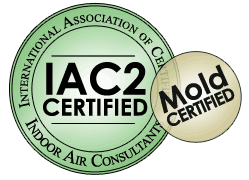
Mold is a known health hazard and should be cleaned and removed when located. Mold inspections are specific to areas of the property where mold is suspected to exist. The inspector will inspect the property to locate any areas of water intrusion, which is typically the source for mold growth. Limited samples will be taken to be analyzed by a lab for the presence of mold. The client may request additional samples to be taken and tested, but the client must pay for the additional Lab fees.
Suspected areas of water intrusion and mold growth will be identified and the suspected areas of mold will be collected and sent to a lab for analysis. The lab analysis will identify the presence of mold to allow the property owner to take the appropriate action. The typical method of mold sampling is air sampling. Air sampling is done by taking one air sample from inside the home and one from outside the home. These two samples are compared for spore counts to determine the presence of a mold hazard. Another available mold test is surface swabbing. The price of a mold inspection is $460, which includes the air sampling and lab testing. Each additional test requested is an extra fee of $80, which covers handling and lab fees. The lab testing typically takes three days before results are available. Upon completion of the lab analysis, you will receive a report from 805 Home Inspections detailing the inspection and results of the lab testing. You will also receive a copy of the original lab results.
Don’t wait until it’s too late! Have your home, or future home checked immediately. If you smell musty odors, or just suspect a problem, get it checked. Do not put you or your family at risk.
Molds are Possible Health Hazards The following is from the recent (July, 2009) World Health Organization’s Guidelines for Indoor Air Quality, Dampness and Mold, which confirms that mold is a health hazard and that inspection and measurements can be used to confirm indoor microbial growth. The conditions that contribute to the health risk were summarized as follows: The prevalence of indoor dampness varies widely within and among countries, continents and climate zones. It is estimated to affect 10-50% of indoor environments in Europe, North America, Australia, India and Japan. In certain settings, such as river valleys and coastal areas, the conditions of dampness are substantially more severe than the national averages for such conditions. The amount of water on or in materials is the most important trigger of the growth of microorganisms, including fungi, actinomycetes and other bacteria. Microorganisms are ubiquitous. Microbes propagate rapidly wherever water is available. The dust and dirt normally present in most indoor spaces provide sufficient nutrients to support extensive microbial growth. While mold can grow on all materials, selection of appropriate materials can prevent dirt accumulation, moisture penetration and mold growth. Microbial growth may result in greater numbers of spores, cell fragments, alergens, mycotoxins, endotoxins, β-glucans and volatile organic compounds in indoor air. The causative agents of adverse health effects have not been identified conclusively, but an excess level of any of these agents in the indoor environment is a potential health hazard. Microbial interactions and moisture-related physical and chemical emissions from building materials may also play a role in dampness-related health effects. Building standards and regulations with regard to comfort and health do not sufficiently emphasize requirements for preventing and controlling excess moisture and dampness. Apart from its entry during occasional events (such as water leaks, heavy rain and flooding), most moisture enters a building in incoming air, including that infiltrating through the building envelope or that resulting from the occupants’ activities. Allowing surfaces to become cooler than the surrounding air may result in unwanted condensation. Thermal bridges (such as metal window frames), inadequate insulation and unplanned air pathways, or cold water plumbing and cool parts of air-conditioning units can result in surface temperatures below the dew point of the air and in dampness.Molds Can Cause Structure Damage
Why Be Concerned? Mold is not usually a problem indoors-unless mold spores land on a wet or damp spot and begin growing. As molds grow they digest whatever they are growing on. Unchecked mold growth can damage buildings and furnishings; molds can rot wood, damage drywall, and eventually cause structural damage to buildings. Mold can cause cosmetic damage, such as stains, to furnishings. The potential human health effects of mold are also a concern. It is important, therefore, to prevent mold from growing indoors. There are three (3) reasons why there should be a concern about fungi in the indoor environment:- Potential health effects of exposure to fungi and their byproducts;
- The effect of fungal contamination on the structural integrity of a building; and
- The negative aesthetic effects fungi can produce both visually and on the human olfactory systems.